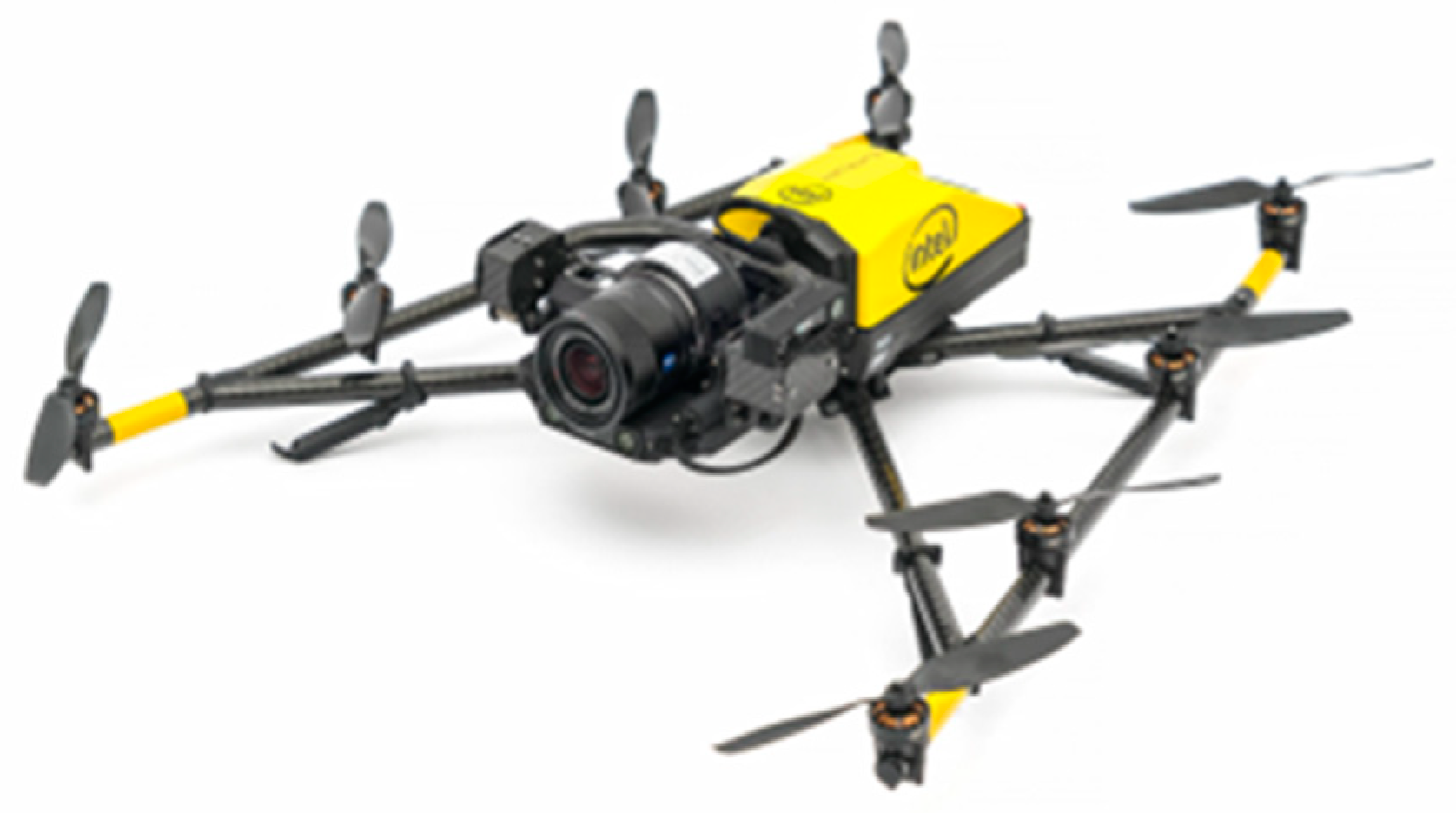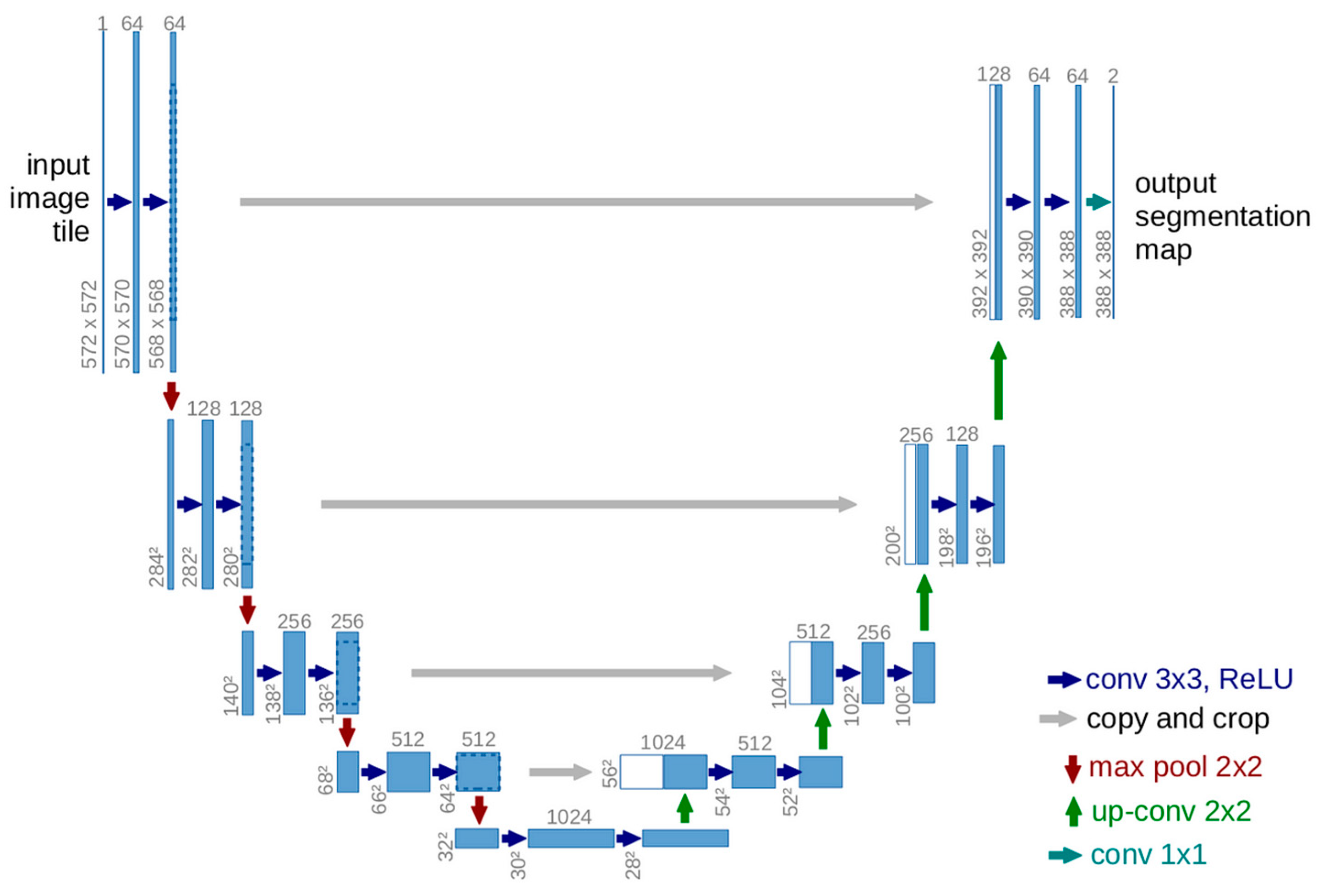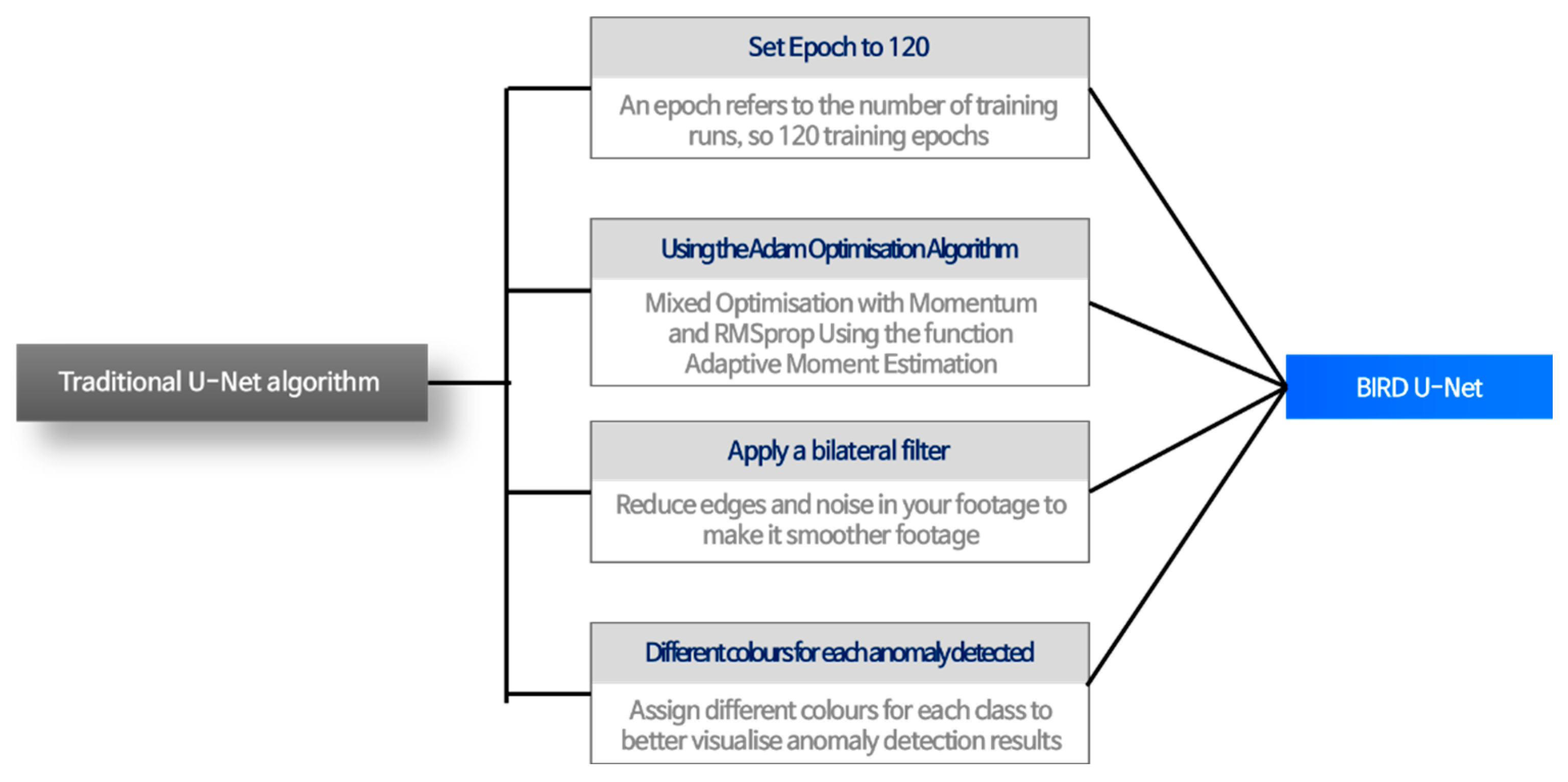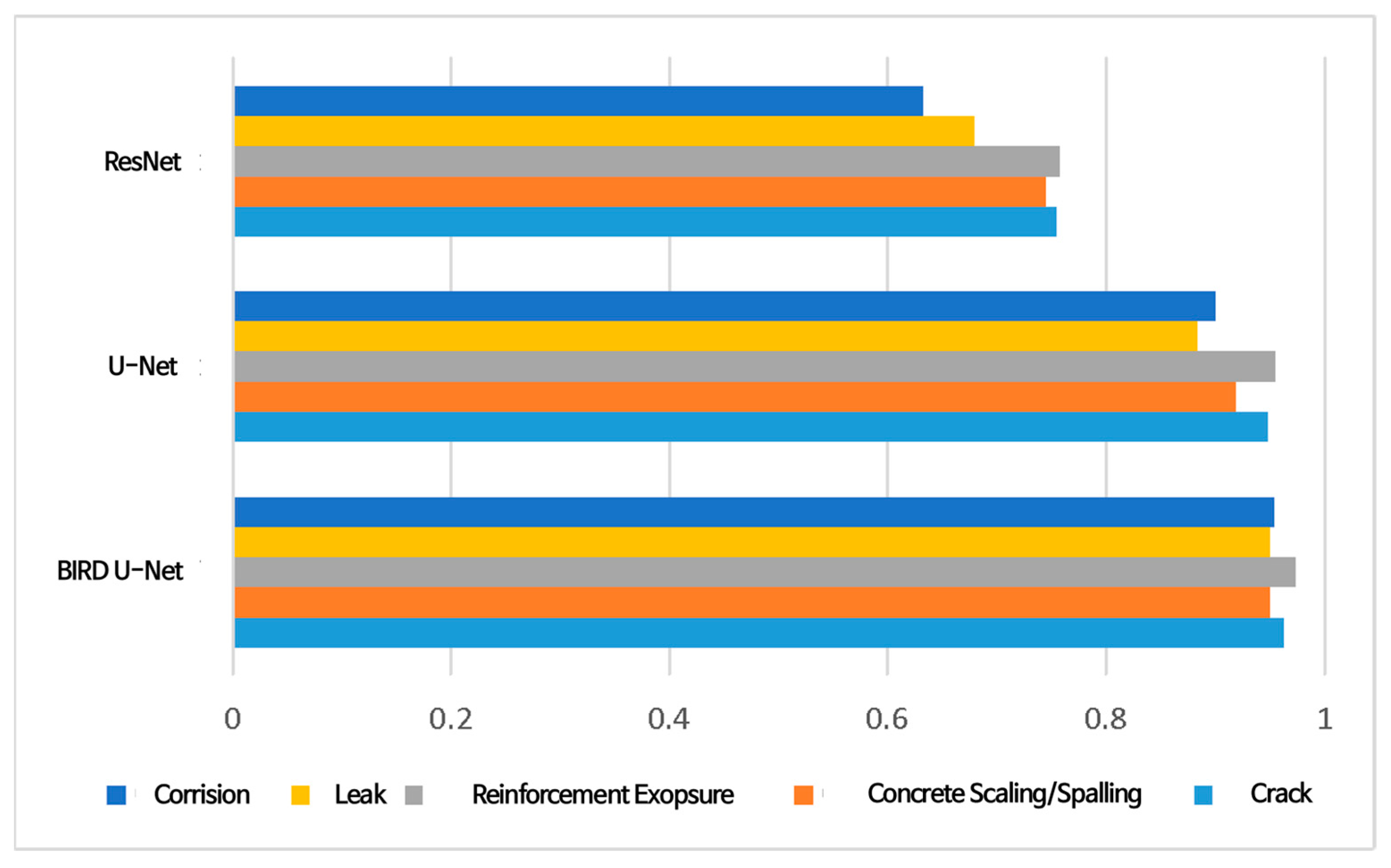Analytical Method for Bridge Damage Using Deep Learning-Based Image Analysis Technology
Abstract
:1. Introduction
2. Previous Research
2.1. Reviewing Prior Research
2.2. Reviewing Unmanned Aerial Vehicles for Bridge Exterior Image Acquisition
2.3. Image Acquisition Equipment Selection and Shooting Conditions
2.4. Selecting a Bridge Exterior Image Acquisition Target and Collecting Damage Images
2.5. Acquisition Image Preprocessing and Feature Point Extraction
3. Damage Detection Methods
3.1. Review of Deep Learning-Based Analytics
- ;
- ;
- : activation value at position x of channel k.
3.2. Crack Detection Algorithms
3.3. How to Validate Crack Detection Algorithms

3.4. Analysis Results
4. Conclusions
Author Contributions
Funding
Institutional Review Board Statement
Informed Consent Statement
Data Availability Statement
Acknowledgments
Conflicts of Interest
References
- Golding, V.P.; Gharineiat, Z.; Munawar, H.S.; Ullah, F. Crack Detection in Concrete Structures using Deep Learning. Sustainability 2022, 14, 8117. [Google Scholar] [CrossRef]
- Na, Y.H.; Park, M.Y. A Study of Railway Bridge Automatic Damage Analysis Method using Unmanned Aerial Vehicle and Deep Learning-Based Image Analysis Technology. J. Soc. Disaster Inf. 2021, 17, 556–567. [Google Scholar]
- Kaur, R.; Karmakar, G.; Xia, F.; Imran, M. Deep learning: Survey of environmental and camera impacts on internet of things images. Artif. Intell. Rev. 2023, 56, 9605–9638. [Google Scholar] [CrossRef] [PubMed]
- Lovelace, B.; Zink, J. Unmanned Aerial Vehicle Bridge Inspection Demonstration Project; Research Project Final Report; Minnesota Department of Transportation Research Services & Library: St. Paul, MN, USA, 2015; Report no. 40. [Google Scholar]
- Chanda, S.; Bu, G.; Guan, H.; Jo, J.; Pal, U.; Loo, Y.; Blumenstein, M. Automatic Bridge Crack Detection–a Texture Analysis-Based Approach. In Proceedings of the Artificial Neural Networks in Pattern Recognition: 6th IAPR TC 3 International Workshop, ANNPR 2014, Montreal, QC, Canada, 6–8 October 2014; Proceedings 6. pp. 193–203. [Google Scholar]
- Irizarry, J.; Gheisari, M.; Walker, B.N. Usability Assessment of Drone Technology as Safety Inspection Tools. J. Inf. Technol. Constr. (ITcon) 2012, 17, 194–212. [Google Scholar]
- De Melo, R.R.S.; Costa, D.B.; Álvares, J.S.; Irizarry, J. Applicability of Unmanned Aerial System (UAS) for Safety Inspection on Construction Sites. Saf. Sci. 2017, 98, 174–185. [Google Scholar] [CrossRef]
- Jung, I.-W.; Park, J.-B.; Kwon, J.-H. Smart facility maintenance using unmanned vehicles. Water Future J. Korean Water Resour. Soc. 2016, 49, 96–99. [Google Scholar]
- Lee, R.; Shon, H.; Kim, R. Case Study on the Safety Inspection using Drones. KSCE Mag. 2017, 65, 75–79. [Google Scholar]
- Kang, S.C.; Kim, C.S.; Jung, J.I.; Kim, E.J.; Park, J.W. A Study on the Method of Facility Management and the Effectiveness of 3D Mapping using Drone in Large Areas. Korean Assoc. Comput. Educ. 2021, 25, 223–226. [Google Scholar]
- Wu, Q.; Song, Z.; Chen, H.; Lu, Y.; Zhou, L. A Highway Pavement Crack Identification Method Based on an Improved U-Net Model. Appl. Sci. 2023, 13, 7227. [Google Scholar] [CrossRef]
- Hadinata, P.N.; Simanta, D.; Eddy, L.; Nagai, K. Multiclass Segmentation of Concrete Surface Damages Using U-Net and DeepLabV3+. Appl. Sci. 2023, 13, 2398. [Google Scholar] [CrossRef]
- Kang, J.O.; Lee, Y.C. Preliminary Research for Drone Based Visual-Safety Inspection of Bridge. Proc. Korean Soc. Geospat. Inf. Sci. 2016, 2016, 207–210. [Google Scholar]
- Jeon, S.-H.; Jung, D.-H.; Kim, J.-H.; Kevin, R. State-of-the-art deep learning algorithms: Focusing on civil engineering applications. J. Korean Soc. Civ. Eng. 2019, 67, 90–94. [Google Scholar]
- Kim, Y.N.; Bae, H.J.; Kim, Y.M.; Jang, K.J.; Kim, J.P. Deep learning based multiple damage type detection system for bridge structures. Proc. Korean Inf. Sci. Assoc. 2021, 48, 582–584. [Google Scholar]
- Hong, S.S.; Hwang, C.; Kim, H.K.; Kim, B.K. A Deep Learning-Based Bridge Image Pretreatment and Damaged Objects Automatic Detection Model for Bridge Damage Management. Converg. Inf. Serv. Technol. 2021, 10, 497–511. [Google Scholar] [CrossRef]
- Cardellicchio, A.; Ruggieri, S.; Nettis, A.; Renò, V.; Uva, G. Physical interpretation of machine learning-based recognition of defects for the risk management of existing bridge heritage. Eng. Fail. Anal. 2023, 149, 107237. [Google Scholar] [CrossRef]
- Rao, A.S.; Nguyen, T.; Palaniswami, M.; Ngo, T. Vision-Based Automated Crack Detection using Convolutional Neural Networks for Condition Assessment of Infrastructure. Struct. Health Monit. 2021, 20, 2124–2142. [Google Scholar] [CrossRef]
- Dais, D.; Bal, I.E.; Smyrou, E.; Sarhosis, V. Automatic Crack Classification and Segmentation on Masonry Surfaces using Convolutional Neural Networks and Transfer Learning. Autom. Constr. 2021, 125, 103606. [Google Scholar] [CrossRef]
- Macaulay, M.O.; Shafiee, M. Machine Learning Techniques for Robotic and Autonomous Inspection of Mechanical Systems and Civil Infrastructure. Auton. Intell. Syst. 2022, 2, 8. [Google Scholar] [CrossRef]
- Lu, M.; Hu, Y.; Lu, X. Dilated Light-Head R-CNN using Tri-Center Loss for Driving Behavior Recognition. Image Vis. Comput. 2019, 90, 103800. [Google Scholar] [CrossRef]
- Bui, H.M.; Lech, M.; Cheng, E.; Neville, K.; Burnett, I.S. Using Grayscale Images for Object Recognition with Convolutional-Recursive Neural Network. In Proceedings of the 2016 IEEE Sixth International Conference on Communications and Electronics (ICCE), Ha Long, Vietnam, 27–29 July 2016; pp. 321–325. [Google Scholar]
- Xie, Y.; Richmond, D. Pre-Training on Grayscale Imagenet Improves Medical Image Classification. In Computer Vision—ECCV 2018 Workshops. ECCV 2018. Lecture Notes in Computer Science; Springer: Cham, Switzerland, 2018. [Google Scholar]
- Shahriar, M.T.; Li, H. A Study of Image Pre-Processing for Faster Object Recognition. arXiv 2020, arXiv:2011.06928. [Google Scholar]
- Long, J.; Shelhamer, E.; Darrell, T. Fully Convolutional Networks for Semantic Segmentation. In Proceedings of the IEEE Conference on Computer Vision and Pattern Recognition, Boston, MA, USA, 7–12 June 2015; pp. 3431–3440. [Google Scholar]
- Ronneberger, O.; Fischer, P.; Brox, T. U-Net: Convolutional Networks for Biomedical Image Segmentation. In Medical Image Computing and Computer-Assisted Intervention–MICCAI 2015: 18th International Conference, Munich, Germany, 5–9 October 2015; Springer: Cham, Switzerland, 2015; Part III 18; pp. 234–241. [Google Scholar]
- Yu, X.; Kuan, T.-W.; Tseng, S.-P.; Chen, Y.; Chen, S.; Wang, J.-F.; Gu, Y.; Chen, T. EnRDeA U-Net Deep Learning of Semantic Segmentation on Intricate Noise Roads. Entropy 2023, 25, 1085. [Google Scholar] [CrossRef]









| Class | Before Augmentation (Original Images) | After Augmentation |
|---|---|---|
| Crack | 22,863 | 91,452 |
| Scaling/spalling | 1587 | 6348 |
| Reinforcement exposure | 5364 | 21,456 |
| Leak | 1962 | 7848 |
| Corrosion | 2148 | 8592 |
| Total | 33,924 | 135,696 |
| Parameter | Value |
|---|---|
| OS | Windows 11 Home |
| Python | 3.9.12 |
| PyTorch | 1.1.0+cu113 |
| Learning Epoch | 120 |
| Learning Rate | 0.001(base) |
| Optimizer | Adam |
| Items | Cracks | Scaling/Spalling | Reinforcement Exposure | Leaks | Corrosion |
|---|---|---|---|---|---|
| BIRD U-Net | 0.9631 | 0.9498 | 0.9732 | 0.9498 | 0.9539 |
| Segmentation method (U-Net) | 0.9483 | 0.9186 | 0.9551 | 0.883 | 0.9004 |
| ResNet | 0.7547 | 0.7452 | 0.7575 | 0.6792 | 0.6322 |
Disclaimer/Publisher’s Note: The statements, opinions and data contained in all publications are solely those of the individual author(s) and contributor(s) and not of MDPI and/or the editor(s). MDPI and/or the editor(s) disclaim responsibility for any injury to people or property resulting from any ideas, methods, instructions or products referred to in the content. |
© 2023 by the authors. Licensee MDPI, Basel, Switzerland. This article is an open access article distributed under the terms and conditions of the Creative Commons Attribution (CC BY) license (https://creativecommons.org/licenses/by/4.0/).
Share and Cite
Jang, K.; Song, T.; Kim, D.; Kim, J.; Koo, B.; Nam, M.; Kwak, K.; Lee, J.; Chung, M. Analytical Method for Bridge Damage Using Deep Learning-Based Image Analysis Technology. Appl. Sci. 2023, 13, 11800. https://doi.org/10.3390/app132111800
Jang K, Song T, Kim D, Kim J, Koo B, Nam M, Kwak K, Lee J, Chung M. Analytical Method for Bridge Damage Using Deep Learning-Based Image Analysis Technology. Applied Sciences. 2023; 13(21):11800. https://doi.org/10.3390/app132111800
Chicago/Turabian StyleJang, Kukjin, Taegeon Song, Dasran Kim, Jinsick Kim, Byeongsoo Koo, Moonju Nam, Kyungil Kwak, Jooyeoun Lee, and Myoungsug Chung. 2023. "Analytical Method for Bridge Damage Using Deep Learning-Based Image Analysis Technology" Applied Sciences 13, no. 21: 11800. https://doi.org/10.3390/app132111800
APA StyleJang, K., Song, T., Kim, D., Kim, J., Koo, B., Nam, M., Kwak, K., Lee, J., & Chung, M. (2023). Analytical Method for Bridge Damage Using Deep Learning-Based Image Analysis Technology. Applied Sciences, 13(21), 11800. https://doi.org/10.3390/app132111800






